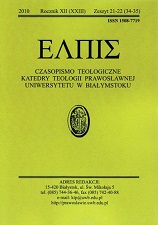Grecki mnich Teodor pierwszym Prymasem Anglii
Greek Monk Theodore as the first Primate of Canterbury
Author(s): Warsonofiusz DoroszkiewiczSubject(s): Christian Theology and Religion
Published by: Wydawnictwo Uniwersytetu w Białymstoku
Keywords: England; Byzantine Empire; history; Christianity
Summary/Abstract: The theological climate of the young Church of Anglo-Saxon Christians was determined by Irish and Welsh monks maintaining the tradition of the Egyptian desert. The Angles and Saxons had a particular vision of the natural world, of the eternal world, a particular comprehension of sin and repentance. Rome in its missionary work used them to attach the British Christians the see of St Peter. Britain had no original link with the culture and tradition of the classical Church. It has been particularly established and enforced in VII and VIII, when England received a great dose of classical learning and theology due to the activity of archbishop of Canterbury Theodore and monk Hadrian. The formerly Greek monk Theodore – well learned in the Holy Scripture as well as Greek and Latin classics – was named the archbishop of Canterbury by pope Vitalian under the condition that he should notintroduce any typically Greek customs. Theodore named Hadrian the abbot of the Canterbury monastery of St Peter. There and in York young English could pursue classical studies of the Holy Scriptures, poetry, philosophy, mathematics, astronomy, etc. It resulted in significant literary development in Britain, of which venerable Bede is an example. Theodore introduced in Canterbury proto-byzantine canonical law, during two famous synods established doctrinal and ecclesiastical foundations of English Christianity based on ancient orthodox tradition of Eastern part of the Mediterranean region. At the Synod of Hatfield,with the other bishops, Theodore confirmed the Nicean Creed, fiveformer ecumenical councils and the generally accepted Church Fathers. They worked also on practical church unity, that is established: common date of Easter with other parts of Christian world, non-intervention ofbishops in other dioceses, canonical laws regulating the attitude of bishops towards monastic communities and the decrees against monophysismonks coming from Persia.
Journal: Elpis
- Issue Year: 2010
- Issue No: 12
- Page Range: 177-194
- Page Count: 18
- Language: Polish

